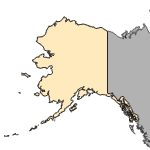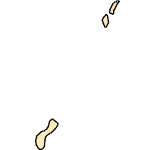Amphiuma tridactylum
(Three-toed Amphiuma)
Amphibians-Salamanders
Native Transplant |
|
Common name: Three-toed Amphiuma
Taxonomy: available through
www.itis.gov
Native Range: The distribution of Amphiuma tridactylum is within the Gulf Coast Plain, centered on the lower Mississippi River from Texas to western Alabama, and north to southern Illinois and extreme southwestern Kentucky (Behler, 1979).



|

Alaska |

Hawaii |

Puerto Rico &
Virgin Islands |

Guam Saipan |
Hydrologic Unit Codes (HUCs) Explained
Interactive maps: Point Distribution Maps
Nonindigenous Occurrences:
Table 1. States with nonindigenous occurrences, the earliest and latest observations in each state, and the tally and names of HUCs with observations†. Names and dates are hyperlinked to their relevant specimen records. The list of references for all nonindigenous occurrences of Amphiuma tridactylum are found here.
Table last updated 1/16/2026
† Populations may not be currently present.
Ecology: The Three-toed Amphiuma often is found in bottomland marshes and lakes, bayous, cypress sloughs, and streams in hilly regions, frequently occupying crayfish burrows (Conant, 1975; Behler and King, 1979; Conant and Collins, 1998; Petranka, 1998). It is especially abundant in drainage ditches in suburban and agricultural areas of the lower Mississippi River (Behler and King, 1979). This amphiuma will move overland during and following heavy rains (Behler and King, 1979; Conant and Collins, 1998). It spends most of the time hiding in heavily vegetated areas of permanent bodies of slow moving water, such as swamps, ponds, and lakes. The adult Three-toed Amphiuma is capable of burrowing through soft mud and utilizing crayfish burrows. It can remain in these refugia for many months without feeding during droughts. This species often moves on land during nights with heavy rainstorms. They have been observed 12 m from the water’s edge (Petranka, 1998).
Amphiuma tridactylum is a nocturnal carnivore. Crawfish constitute a large proportion of the diet, followed by annelids, insects, mollusks, fishes, small turtles, and sometimes skinks along the shoreline (Chaney 1951; Fontenot and Fontenot, 1989). This species is preyed upon by Mudsnakes (Faracina abacura) and Cottonmouths (Agkistrodon piscivorous) (Behler, 1979; Petranka, 1998).
Mating occurs from December to June, and nesting from April to October. Unlike other amphiumas, this species has internal fertilization (Kreeger, 1942; Cagle, 1948; Petranka, 1998). The females are capable of storing viable sperm for at least 6–8 months (Kreeger 1942). Clutch size ranges from 44–282 with an average of 201 (Fontenot, 1999). Eggs are deposited in the water near land in coiled strings and are guarded by the female until hatching. The eggs generally are exposed to air as the water recedes. The larval stage lasts a mere 3 weeks. Sexual maturity is reached in 3–4 years (Petranka, 1998).
Means of Introduction: Pet trade. Several dozen per year are sold from Louisiana as pets, whereas several hundred to about 1,000 are sold annually to biological suppliers for laboratory experiments. Most are taken as off-catch during crayfish trapping.
Status: Based on the fact that several were collected, it is assumed that this species is established.
Impact of Introduction: The impacts of this species are currently unknown, as no studies have been done to determine how it has affected ecosystems in the invaded range. The absence of data does not equate to lack of effects. It does, however, mean that research is required to evaluate effects before conclusions can be made.
References: (click for full references)
Behler, J.L. and F.W. King. 1979. The Audubon Society Field Guide to North American Reptiles and Amphibians. Alfred A. Knopf, Inc., New York. 743 pp.
Conant, R. 1975. A Field Guide to Reptiles and Amphibians of Eastern and Central North America. Houghton Mifflin Company, Boston. 429 pp.
Conant, R. and J.T. Collins. 1998. A Field Guide to Amphibians and Reptiles: Eastern and Central North America. Third edition, expanded. Houghton Mifflin Company, Boston, Massachusetts.
Dundee, H.A. and D.A. Rossman. 1989. The Amphibians and Reptiles of Louisiana. Louisiana State University Press.
Krysko, K.L. and 12 others. 2011. Verified non-indigenous amphibians and reptiles in Florida from 1863 through 2010: Outlining the invasion process and identifying invasion pathways and stages. Zootaxa 3028:1-64.
Petranka, J.W. 1998. Salamanders of the United States and Canada. Smithsonian Institution Press, Washington, D.C.
Author:
Fuller, P.
Revision Date: 4/17/2019
Citation Information:
Fuller, P., 2026, Amphiuma tridactylum Cuvier, 1827: U.S. Geological Survey, Nonindigenous Aquatic Species Database, Gainesville, FL, https://nas.er.usgs.gov/queries/FactSheet.aspx?speciesID=2863, Revision Date: 4/17/2019, Access Date: 1/17/2026
This information is preliminary or provisional and is subject to revision. It is being provided to meet the need for timely best science. The information has not received final approval by the U.S. Geological Survey (USGS) and is provided on the condition that neither the USGS nor the U.S. Government shall be held liable for any damages resulting from the authorized or unauthorized use of the information.